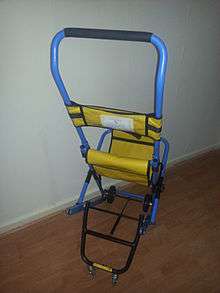Escape chair

An escape chair or evacuation chair is a device manufactured for the smooth descent of stairways in the event of an emergency. The Evac Chair was invented in the United States in 1982. The single-user operation device does not require heavy lifting to evacuate a person.
Types
The original Escape-Chair, with various models for various situations, addresses the need for an evacuation solution in case there is an emergency, and egress out of a structure or vessel becomes imperative.
The table below is based on the Escape-Chair Standard and the Comfort model for comparison.
| Standard | Comfort |
|---|---|
| Seat Belt | 2 Level Telescopic extendable handle. |
| Head Strap | Foot & Armrests |
| Wide Wheelbase For Enhanced Stability | Ergonomic Dual Back Support |
| Height 102 cm | Height 120 cm |
| Width 51 cm | Width 57 cm |
| Depth 18 cm | Depth 21 cm |
| Weight 10 kg | Weight 13.5 kg |
| Payload 150 kg | Payload 150 kg |
These are based on an Evac Chair 300h Mk4 And an IBEX Transeat
| Basic Chair | Advanced Chair |
|---|---|
| Seat Strap | Telescopic extendable handle. |
| Head Strap | Adjustable brake |
| Kickstand with wheels for easy movability | Oxygen cylinder holder |
| Height 104 cm | Height 110 cm |
| Width 52 cm | Width 46 cm |
| Depth 20 cm | Depth 36 cm |
| Weight 9.5 kg | Weight 14.5 kg |
| Payload 182 kg | Payload 159 kg |
Enhanced models can have chairs that require two-person operation; however, these are more commonly used in ambulances. Lifting handles are used for descent and ascent of stairs. Caterpillar tracks are also used on the stairs.
Laws
United Kingdom
The DDA ACT[1] says that every person is to have a safe entrance into and egress from a building.
Another law regarding chairs is the RRFSO.[2] Created in 2005, this regulation states that fire officers are not required to enter buildings.
Failure to follow the above laws can result in serious issues. If a person was to perish in the building due to a lack of adequate evacuation equipment, the owners or operators of the building could be charged with Corporate manslaughter.[3]